John Teague
John Teague adapted Joseph Michaud's 1871 plans for his 1886 addition to St. Ann's Academy, and upon the suggestion of the Sisters, he oversaw the transportation of Michaud's 1858 cathedral to the back of the academy.
& the Architecture of Faith
John Teague adapted Joseph Michaud's 1871 plans for his 1886 addition to St. Ann's Academy, and upon the suggestion of the Sisters, he oversaw the transportation of Michaud's 1858 cathedral to the back of the academy.
John Teague was born in Redruth, Cornwall in June 1835. Teague's father was a mining agent, and Teague was trained in the skills necessary for mine managers like drawing and mathematics. Incidentally, the same skills were necessary in architecture. 1 He left England for Costa Rica in 1856, but he stopped in New York instead. 2 Teague then travelled to California, where he failed as a miner and got a job constructing buildings for the mining companies. He passed through Victoria in 1858 on his way to the Fraser Valley, and then he moved again to the Cariboo in search of gold
1858:Fraser River Gold Rush
1859:Cariboo Gold Rush. 3 Teague experienced remarkable hardship during the gold rush, though he survived better than others he encountered along the way. 4
Teague returned to Victoria in 1860 to contract buildings for the Royal Navy in Esquimalt. He proved himself an able engineer, and he married Emily Birt Albington, who arrived on one of the brideships, in 1863. 5 In 1865, Teague went into undertaking, but his business failed, and he returned to carpentry. 6 Teague had no formal training in architecture, but he started advertising himself as an architect in the mid-1870s. 7
Teague was an aggressive businessman, and he dominated Victoria architecture in the 1870s. With the end of the gold rush
1858:Fraser River Gold Rush
1859:Cariboo Gold Rush Victoria's population declined, and construction went into a recession from 1865 to 1879. 8 Nonetheless, Teague operated a successful business during the 1870's, and he constructed almost all the notable public and commercial buildings during this period. 9 In 1874, Teague built his first major commission, the Reformed Episcopalian Church of Our Lord, in Carpenter Gothic Style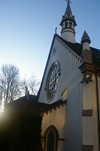
The Reformed Episcopalian Church of Our Lord, in Carpenter Gothic Style. 10 Then following the example of T.S. Scott's Custom's House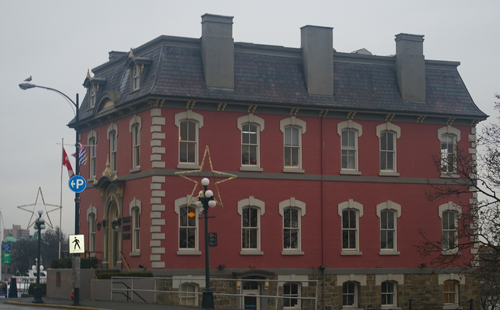
The Victoria Customs House with a Mansard Roof (1874) on Wharf Street, Teague designed the Victoria City Hall in 1875 (built in 1878) and the Masonic Temple (1878) with steep mansard roofs
The Victoria Customs House with a Mansard Roof in the Second Empire Style. 11 Teagues success over the course of the recession, and his decision to operate exclusively as an architect had a tremendous effect on the professionalization of architecture in British Columbia.
Teague continued to thrive in the 1880s and 1890s as an architect. This period saw a construction boom in Victoria, and John Teague, along with Thomas Hooper, took full advantage of it. Teague and Hooper built the vast majority of commercial buildings and hotels on Government Street, Yates Street, Wharf Street, and Johnson Street, and Teague built several buildings in Victoria's rapidly growing Chinatown. The number of architects in Victoria peaked with nineteen in 1895, and Teague had to compete with the likes of Francis Rattenbury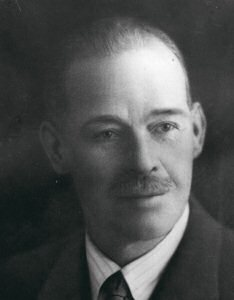
Francis Rattenbury, Thomas Hooper, and Samuel Maclure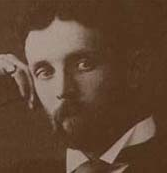
Samuel Maclure, but Teague was still among the most prominent architects in Victoria. 12
Teague exhibited an inconsistent style during his career. Teague was mostly under the architectural influence of California, but he never seriously adopted a specific style for long. He seemed to favour the Italianate style, but he also experimented with Queen Anne Ecclecticism, Second Empire, Georgian, Carpenter Gothic
The Reformed Episcopalian Church of Our Lord, in Carpenter Gothic Style, and Chicago School.13 Teague did not introduce any innovations to Victoria architecture, but he seemed well equipped to adopt any popular late Victorian style his clients wanted.
The Sisters of St. Ann commissioned Teague to construct an addition to St. Ann's Academy in 1886. Teague's design was based on the 1871 plans of Fr. Michaud, and it transformed the 1871 building into the Western wing of a large, symmetrical structure reminiscent of the St. Anne's Motherhouse in Lachine, Quebec. 14 The Sisters came up with the idea to incorporate Michaud's Cathedral across the street into their new building because plans were underway for a new Cathedral on View Street, and Teague approved. 15 St Andrew's was moved across the street to the back of the new addition, where it became the convent chapel. Although, architectural trends in Quebec were inconsistent, the building had an obvious French appearance to observers in British Columbia.
Teague's most important contribution to St. Ann's was in what he did not do. In true Teague fashion, Teague did not deviate much from the will of his clients, nor did he try to adapt his addition to fit Victoria's very different architectural context. St. Ann's was already French-Canadianized in Victoria's imagination, and Teague helped entrench this idea by constructing the 1886 addition the way Victorian's believed Quebec architecture should look. They had, of course, learned from the 1871 wing.
Apart from his personal success, Teague worked to regulate architecture in BC making him instrumental in the process of professionalization. Teague was also active in the Victoria community as a Presbyterian and a Freemason. As a result of professionalization, Teague's social status grew. Teague's success as an architect became success as a politician, and he was elected mayor of Victoria in 1894 and again in 1895.16 In fact, he still listed himself as an architect as well as mayor in the 1895 city directory. 17
Historians Dorothy Mindenhall and Carey Pallister determined that Teague built approximately 350 buildings in thirty years as an architect. 18 Despite this success, Teague's business declined after 1895. Teague was a generous man, and an unwise investor, so he lost his hard-won fortune before he died in 1902. 19
Teague did not follow any specific architectural style. He tried out a number of different styles during his career, but his stylistic choices did not have a lasting affect on subsequent Victoria architecture. Teague was an expert designer, but he mostly let popular trends and his clients determine the direction of his projects.
This negotiation between architect, client, and wider culture existed to some degree in all architectural works. As a result of Teague's particular subservience to trends and his clients, St. Ann's Academy should be viewed not only as the product of architects but also as the product of the Catholic Church in BC, the Sisters of St. Ann, and the consensus of Victorian society. All these people imagined St. Anns a certain way, and John Teague dutifully recorded their belief directly into the building.
This map indicates the location of John Teague's extant buildings in dowtown Victoria. Click on the black house icons to learn more about Teague's buildings and plan a walking tour of Victoria's architecture.
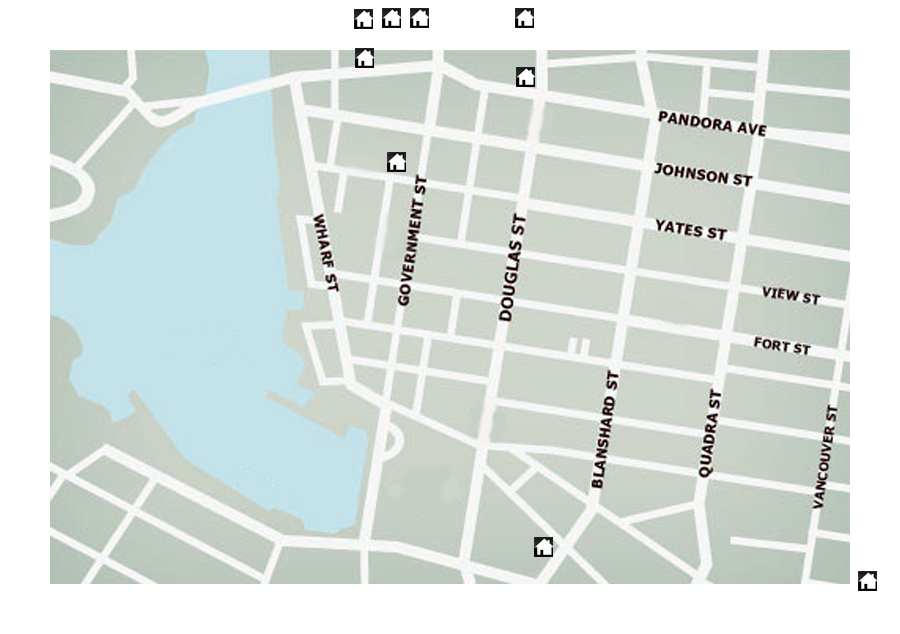
1 Dorothy Mindenhall and Carey Pallister, "John Teague: 1835-1902," Building the West: the Early Architects of British Columbia, Donald Luxton, ed. (Vancouver: Talonbooks, 2003), 75.
2 Martin Segger, "Teague, John," Dictionary of Canadian Biography Online, 2000,
3 Mindenhall and Pallister, 75. And Segger.
4 BCA, Verticle Files, John Teague, J.D. Kerr, "John Teague," Biographical Dictionary of Well-known British Columbians (Vancouver, 1890), 301-4.
5 Colonists in British Columbia sent for the brideships because they believed there existed a shortage of white women in the colony. See Adele Perry, On the Edge of Empire: Gender, Race, and the Making of British Columbia, 1849-1871 (Toronto: University of Toronto Press, 2001).
6 Mindenhall and Pallister, 75.
7 BCA, Victoria City Directories.
8 G.E. Mills, Architectural Trends in Victoria, British Columbia, 1850-1914, Manuscript Report Number 354, (Parks Canada, 1976), 12.
9 Mills, 13.
10 Mindenhall and Pallister, 75.
11 Mills, 13. And Christina Cameron and Janet Wright, Second Empire Style in Canadian Architecture, Canadian Historic Sites, Occasional Papers in Archaeology and History, No 24 (Hull, Quebec: Canadian Government Publishing Centre, Supply and Services Canada, 1980), 58-9, 76-7, 84-5.
12 Mills, 22.
13 Martin Segger and Douglas Franklin, Victoria: A Primer for Regional History in Architecture (Watkins Glen, NY: Pilgrim Guide to Historic Architecture, 1979), 347. And Mindenhall and Pallister, 75-77.
14 "Interpretive Centre: East Block, 1886"St. Ann's Academy: National Historic Site, 2008,
15 Hallmark, "St. Ann's Chronology 3rd Edition," 1986.
16 Mindenhall and Pallister, 78.
17 BCA, Victoria City Directory, 1895.
18 Mindenhall and Pallister, 75.
19 Segger.
Photos:
BCA, "John Teague Sr.," B-00188, n.d.
BCA, "St. Ann's Convent, Victoria," B-09383, c.1890.
BCA, "Victoria, View from Beacon Hill..." A-07746, c.1890.
BCA, From John Teague Providing Details For Lime Ash Floors & Concrete Hearths, Crease Family Correspondence, 1874, Add MSS 55, Box 7, File 55.